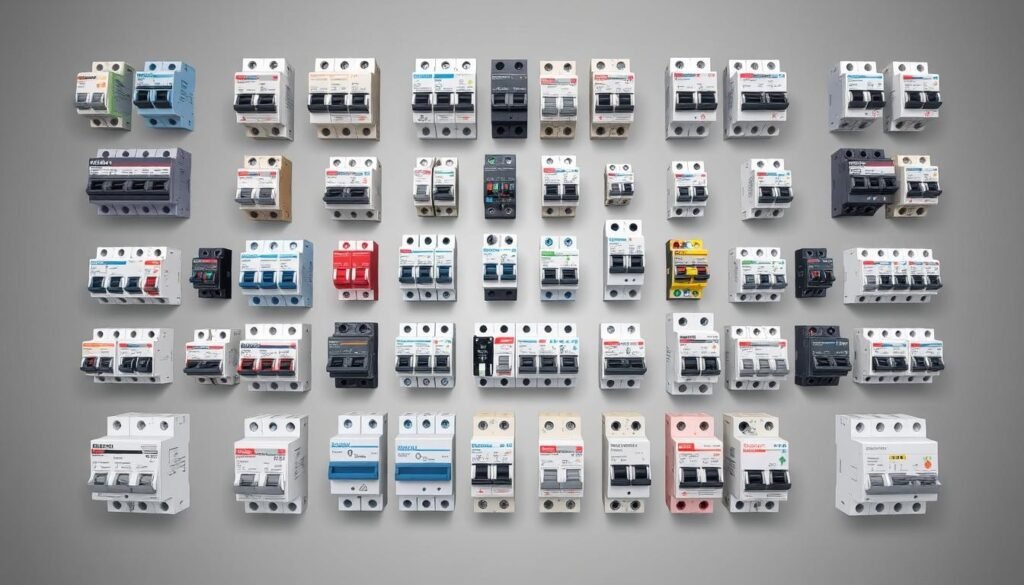Did you know that around 45% of electrical fires are caused by faulty circuits? This is a scary fact that shows how important electrical safety and circuit protection are. Choosing the right MCB can be right solution to it, to keep our homes and businesses safe.
In this guide, we’ll explore how to pick the perfect MCB for your needs. By the end, you’ll know how to protect your electrical systems effectively.
Understanding Miniature Circuit Breakers (MCBs)
A Miniature Circuit Breaker (MCB) is a safety device in electrical systems. It cuts off the circuit when it sees overloading or short-circuits. Unlike old fuses, MCBs can be reset, making them a top pick for electrical safety. It uses thermal and electromagnetic methods to spot faults. This quick action ensures the electrical supply is cut off when it’s unsafe. The reset feature is a big plus, as it means no need to replace it after each fault.
MCBs work by spotting faults in a circuit. When there’s too much current, the bimetallic strip heats up and trips the mechanism. Short circuits, on the other hand, trigger an electromagnetic action that quickly cuts off the circuit. This smart action keeps electrical systems safe in homes and businesses.
| Feature | MCB | Fuse |
|---|---|---|
| Reset Capability | Yes | No |
| Response Time | Fast | Slower |
| Durability | Higher | Lower |
| Maintenance | Low | High |

Before you move forward to our step-by-step guide, understand one fact; both MCBs and Switches are crucial to ensure safety in electrical system.
Click here to learn about the regularity standards one needs to elect the right switch. (Essential Switch and Accessories Standards and Certifications Guide – Anubhav Techno Solutions Pvt. Ltd.)
Step-by-Step Guide to Choosing the Right MCB
1.Determine the Type of Load
The first step in choosing the right MCB is understanding the type of load it will protect. Electrical loads are typically classified into three categories:
- Resistive Load: Includes devices like incandescent bulbs and heaters. These loads have a constant resistance and do not cause high inrush currents.
- Inductive Load: Includes motors, fans, and pumps, which have coils and can cause high inrush currents when started.
- Capacitive Load: Includes capacitors and electronic devices that can draw a significant inrush current when first powered on.
2.Calculate the Current Rating
The current rating of an MCB indicates the maximum current it can carry without tripping under normal conditions. To determine the appropriate current rating, calculate the total load current of the circuit. Add up the wattage of all devices on the circuit, divide by the voltage, and then select an MCB with a slightly higher rating to account for any unexpected surges.


3.Understand the Different Types of MCBs
MCBs are categorised based on their tripping curves, which indicate how quickly they will trip under different levels of overcurrent. The main types are:
| MCB Type | Tripping Characteristics | Typical Applications |
|---|---|---|
| B Curve MCB | Trips between 3 to 5 times rated current | Lighting circuits and domestic appliances |
| C Curve MCB | Trips between 5 to 10 times rated current | Inductive loads, motors, and general industrial applications |
| D Curve MCB | Trips between 10 to 20 times rated current | Applications with high inrush currents, such as transformers and large motors |
4.Consider the Breaking Capacity
The breaking capacity, or short-circuit capacity, is the maximum current that the MCB can interrupt without being damaged. In residential settings, a breaking capacity of 6kA (6000 amps) is typically sufficient, but industrial environments might require higher capacities.
5.Check the Regulatory Standards
Ensure that the MCB you choose complies with the relevant standards for your region, such as IEC 60898 or IS 8828 in India. Compliance with these standards guarantees that the MCB has been tested for safety and reliability.
6.Think About Future Expansion
When selecting an MCB, it’s wise to consider any potential future expansions of your electrical system. Choosing an MCB with a slightly higher current rating or one that can accommodate additional circuits can save time and money in the long run.
In today’s competitive market numbers of manufacturing brands promise consumer for the best quality of MCB and other electrical equipment. We Anubhav Techno Solution will assist you to make a batter choice.
Have a look at this updated and detailed comparison table b/w MCB Manufacturers.

FREQUENTLY ASKED QUESTIONS
Q. What makes an MCB a must-have for your home’s electrical safety?
A. MCBs are like the silent guardians of your home’s electrical system, cutting off power during overloads or short circuits to prevent disasters like electrical fires.
Q. Why should you ditch fuses for MCBs?
A. Tired of replacing blown fuses? MCBs trip and reset with a simple switch flip, saving you time and hassle while offering faster and more reliable protection.
Q. How do you know which MCB is the perfect match for your circuit?
A. It’s all about the load. Whether you’re powering a few lights or heavy machinery, there’s an MCB tailored for your specific needs.
Q. What are the different types of MCBs and their uses?
A. Type B is for domestic appliances, Type C for inductive loads, and Type D for high inrush currents in industrial applications.
Q. How can I calculate the right current rating for my MCB?
A. Add the wattage of all devices, divide by the voltage, and choose an MCB with a slightly higher rating to handle surges.

